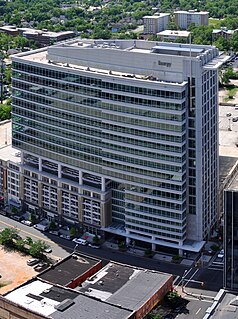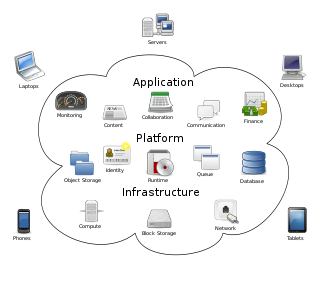Related Research Articles

Red Hat, Inc. is an American IBM subsidiary software company that provides open source software products to enterprises. Founded in 1993, Red Hat has its corporate headquarters in Raleigh, North Carolina, with other offices worldwide.
In computing, cross-platform software is computer software that is designed to work in several computing platforms. Some cross-platform software requires a separate build for each platform, but some can be directly run on any platform without special preparation, being written in an interpreted language or compiled to portable bytecode for which the interpreters or run-time packages are common or standard components of all supported platforms.
Open Source Development Labs (OSDL) was a non-profit organization supported by a consortium to promote Linux for enterprise computing. Founded in 2000, OSDL positioned itself as an independent, non-profit lab for developers who are adding enterprise capabilities to Linux. The headquarters was first incorporated in San Francisco but later relocated to Beaverton in Oregon with second facility in Yokohama, Japan.
An application program is a computer program designed to carry out a specific task other than one relating to the operation of the computer itself, typically to be used by end-users. Word processors, media players, and accounting software are examples. The collective noun refers to all applications collectively. The other principal classifications of software are system software, relating to the operation of the computer, and utility software ("utilities").
Workspot was the first Linux desktop Web Service, i.e. it provided Open Source personal computing without computer ownership. Founded by Greg Bryant, Gal Cohen, Kathy Giori, Curt Brune, Benny Soetarman, Bruce Robertson, and Asao Kamei, in 1999, it was the first application service to make use of Virtual Network Computing. Workspot also hosted a free Linux Desktop demo using VNC: 'one-click to Linux' It eventually began to charge for a remote, web-accessible, persistent desktop, and several desktop collaboration features. Workspot won Linux Journal's Best Web Application award for 2000. Badly hit by the dotcom crash, it ceased activity by 2005.
In computing, a solution stack or software stack is a set of software subsystems or components needed to create a complete platform such that no additional software is needed to support applications. Applications are said to "run on" or "run on top of" the resulting platform.
In computing, minimalism refers to the application of minimalist philosophies and principles in the design and use of hardware and software. Minimalism, in this sense, means designing systems that use the least hardware and software resources possible.
Olga Volchkova is a Russian-born artist currently resident in Eugene, Oregon.

Linux is a family of open-source Unix-like operating systems based on the Linux kernel, an operating system kernel first released on September 17, 1991, by Linus Torvalds. Linux is typically packaged in a Linux distribution.
The RS Media is another product in WowWee's line of biomorphic robots, based on a walking system designed by Mark Tilden. The RS Media uses basically the same body as the Robosapien V2, but a different brain based on a Linux kernel. As the name implies, the RS Media's focus is on multimedia capabilities, including the ability to record and playback audio, pictures and video. he retains and builds upon the Robosapien V2's sensor array and programmability.
Indic Computing means "computing in Indic", i.e., Indian Scripts and Languages. It involves developing software in Indic Scripts/languages, Input methods, Localization of computer applications, web development, Database Management, Spell checkers, Speech to Text and Text to Speech applications and OCR in Indian languages.

Cloud computing is the on-demand availability of computer system resources, especially data storage and computing power, without direct active management by the user. Large clouds often have functions distributed over multiple locations, each location being a data center. Cloud computing relies on sharing of resources to achieve coherence and economies of scale, typically using a "pay-as-you-go" model which can help in reducing capital expenses but may also lead to unexpected operating expenses for unaware users.

Unix is a family of multitasking, multiuser computer operating systems that derive from the original AT&T Unix, whose development started in 1969 at the Bell Labs research center by Ken Thompson, Dennis Ritchie, and others.
An application programming interface (API) is a connection between computers or between computer programs. It is a type of software interface, offering a service to other pieces of software. A document or standard that describes how to build or use such a connection or interface is called an API specification. A computer system that meets this standard is said to implement or expose an API. The term API may refer either to the specification or to the implementation.
An app store is a type of digital distribution platform for computer software called applications, often in a mobile context. Apps provide a specific set of functions which, by definition, do not include the running of the computer itself. Complex software designed for use on a personal computer, for example, may have a related app designed for use on a mobile device. Today apps are normally designed to run on a specific operating system—such as the contemporary iOS, macOS, Windows or Android—but in the past mobile carriers had their own portals for apps and related media content.
The following outline is provided as an overview of and topical guide to computers:
Linux kernel-based operating systems have been widely adopted in a very wide range of uses. All the advantages and benefits of free and open-source software apply to the Linux kernel, and to most of the rest of the system software.

Tango was an augmented reality computing platform, developed and authored by the Advanced Technology and Projects (ATAP), a skunkworks division of Google. It used computer vision to enable mobile devices, such as smartphones and tablets, to detect their position relative to the world around them without using GPS or other external signals. This allowed application developers to create user experiences that include indoor navigation, 3D mapping, physical space measurement, environmental recognition, augmented reality, and windows into a virtual world.
Microsoft, a technology company known for its opposition to the open source software paradigm, turned to embrace the approach in the 2010s. From the 1970s through 2000s under CEOs Bill Gates and Steve Ballmer, Microsoft viewed the community creation and sharing of communal code, later to be known as free and open source software, as a threat to its business, and both executives spoke negatively against it. In the 2010s, as the industry turned towards cloud, embedded, and mobile computing—technologies powered by open source advances—CEO Satya Nadella led Microsoft towards open source adoption although Microsoft's traditional Windows business continued to grow throughout this period generating revenues of 26.8 billion in the third quarter of 2018, while Microsoft's Azure cloud revenues nearly doubled.
References
- ↑ "One Man's Broadway: Think Small". The Eugene Register-Guard. February 24, 2007.
- ↑ "Workspot Linux". The Register. January 24, 2003.
- ↑ "Linux-friendly ASP surfaces". CNN. April 10, 2000.
- ↑ "Immortal Machines". The Independent. February 28, 2000. Archived from the original on December 6, 2012.
- ↑ "Linux Desktop". Bruce Sterling's Infinite Matrix. February 6, 2003.
- ↑ "Rain in the Press". Rain Magazine. Fall 1992.
- ↑ "The Origins of Pattern Theory". IEEE Software. September–October 1999.
- ↑ "Gatemaker and the Aspen Summit".
- ↑ "On writing simulators and the Use of Macros". West Coast Computer Faire. March 1983.
- ↑ "Happening People". Eugene Weekly. September 18, 2008.
- ↑ "Location Based Services".
- ↑ "Google's first mobile product".
- ↑ "The beginning of eBay mobile".
- ↑ "Unfolding Sequences". Core Memory. February 5, 2009.
- ↑ "Applications of Grogix".
- ↑ "Computing Philosophy".
- 1 2 "PUARL Conference". University of Oregon. November 2013. Archived from the original on May 12, 2014. Retrieved May 9, 2014.
- ↑ "Urbanology".
- ↑ "Downtown Eugene".
- ↑ "The Tango Center".